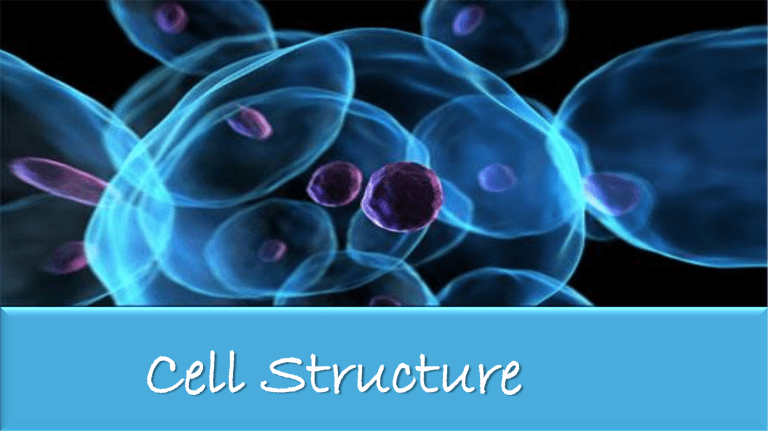Cell Structure: Animal, Plant Cells & Microscopy
advertisement

Cell Structure Animal Cell Plant Cell Cell Wall Made of cellulose They are fully permeable Function: They support, strengthen and protect the plant cell. Cell Membrane Phospholipid Membranes are composed of phospholipids and proteins Phospholipid bilayer Phospholipids are arranged into double layers (bilayer) The phosphate heads (hydrophilic) are exposed to the outer surfaces The lipid tails (hydrophobic) face into the middle Membrane proteins can also be found embedded in the phospholipid bilayer Function of Membrane • Control what enters and leaves the cell • Semi-permeable • Retain cell contents • Give support to the cell • Recognise molecules that touch them The Cell Membrane A membrane is said to be PERMEABLE to a substance if the substance can pass through it. A membrane is said to be IMPERMEABLE to a substance if the substance cannot pass through it Permeable Impermeable Selectively/Semi Permeable • Cell membranes are SELECTIVELY/SEMI PERMEABLE. • They allow water, Carbon Dioxide and Oxygen to pass through freely.(small molecules) • They do not allow sugars, proteins and salts to pass though easily. (larger molecules) Nucleolus Makes ribosomes Nucleolus Cytoplasm Jelly-like liquid that surrounds the nucleus. Organelles (mitochondria, chloroplast and ribosomes) are suspended in the cytoplasm, allowing them to move. Ribosomes Tiny bead-like structures Function: to make proteins Ribosomes Mitochondria Respiration occurs here! Therefore mitochondria produce ENERGY!!! Cells that have many mitochondria produce lots of energy (Muscle cells) Cells with few mitochondria produce less energy (Fat cells) Chloroplast • Found in plant cells only! Function: Photosynthesis Nuclear pores • Allow a type of RNA (ribonucleic acid) called mRNA (messenger RNA) to pass in and out! Cell Membrane Animal Cell Plant Cell Prokaryotic Cells and Eukaryotic Cells Prokaryotic Cells Do not have a nucleus or membrane-enclosed organelles • E.g. Bacteria Eukaryotic Cells • Have a nucleus and membrane bound organelles. • Eg. Human cell Stage clips Light Source Base Arm Low Power Eyepiece Body Tube Diaphragm Medium Power Fine Focus Knob Objective Lens Nosepiece High Power Coarse Focus Knob Stage Objective Lens Compound Light Microscope Uses 2 lenses – objective lens and eyepiece lens • The total magnification of the image is calculated by multiplying the power of the two lenses Light source: AThe bulbmicroscope or mirror that illuminates the specimen Diaphragm: Controls the amount of light passing into the specimen Objective Lenses: Magnifies the specimen by different powers Coarse Focus Wheel: The the microscope Bring specimen into rough focus Fine Focus Wheel: Brings the specimen into precise focus Scanning Electron Microscope Scanning Electron Microscope (SEM) • Uses beams of electrons to provide a surface view of the specimen Images taken using SEM Images taken using SEM Plant Cell Animal Cell Bacterium Cell Transmission Electron Microscope Transmission Electron Microscope (TEM) Sends a beam of electrons through a thin section of the specimen Shows internal structure in great detail Preparing and Examining Cells Learning Check! • Why is a thin specimen used? • How did you collect a sample of this specimen? • Why is water added to the specimen? • Name the stain used? • Why do we use a stain when preparing a specimen? • Why is a cover slip used? • Why is a cover slip placed on at a 45 degree angle? • Why do you always start with the lowest lens? • Why do you adjust the coarse focus wheel first? Learning Check! • What animal cell did you use? • Give an example of how you can get an animal cell sample? • Why is water added to the specimen? • Name the stain used? • What colour was the stain? • Why do we use a stain when preparing a specimen? • Why is a cover slip used? • Why is a cover slip placed on at a 45 degree angle? • What are the differences between a plant and animal cell?

